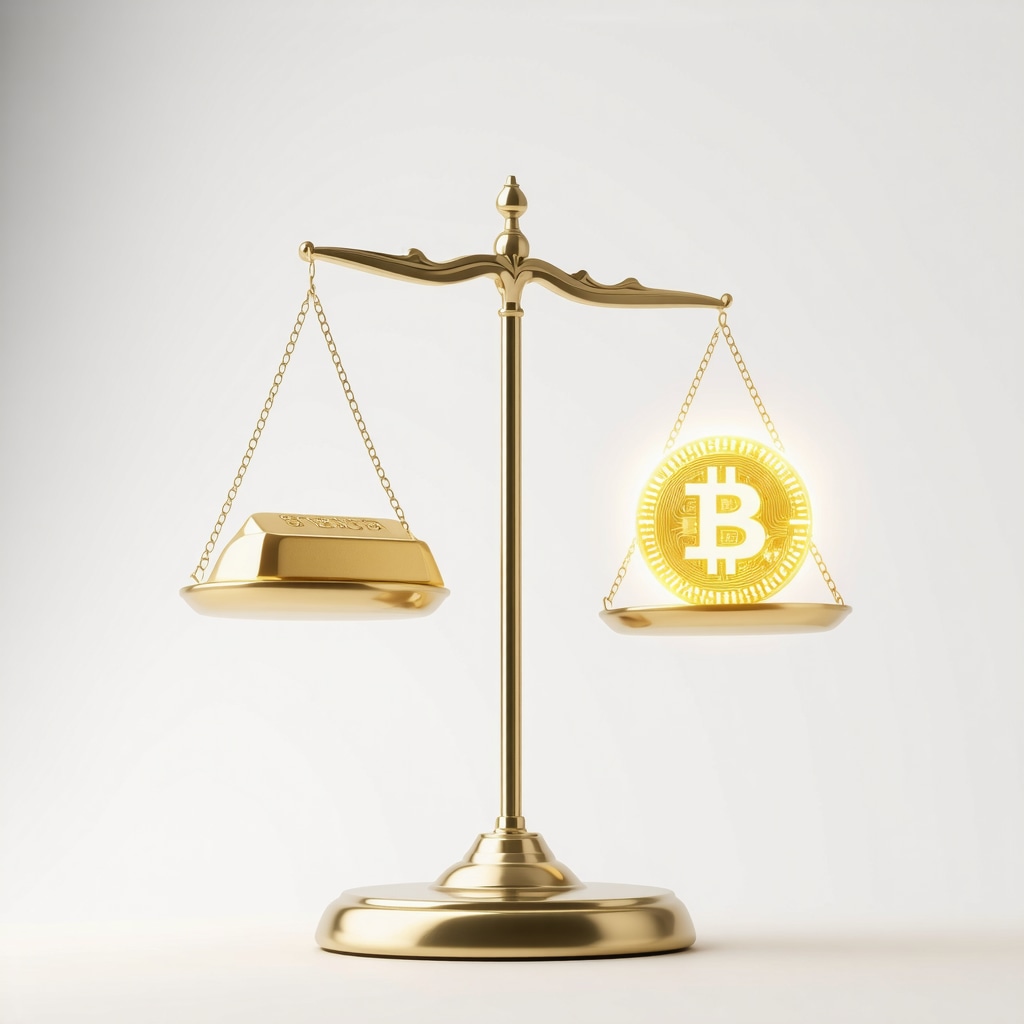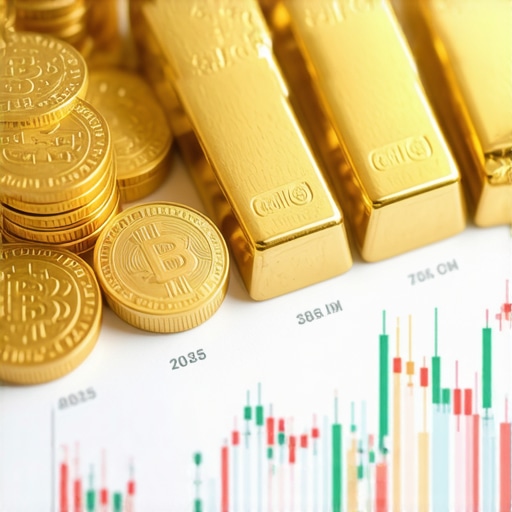Unlocking the Value: Why Gold Remains a Timeless Investment
Gold has long been revered as a safe haven asset, but in today’s rapidly evolving financial landscape, investors face a pivotal choice: should they invest in physical gold or its digital counterpart? This question transcends mere preference; it touches on liquidity, security, convenience, and long-term value preservation. To navigate this complex decision, it’s essential to understand the nuanced dynamics that differentiate physical gold from digital gold investments.
Weighing Tangibility Against Convenience: The Core Differences
Physical gold—encompassing coins, bars, and bullion—is prized for its tangible nature. Holding physical gold delivers a psychological comfort and intrinsic value that digital formats strive to emulate but cannot fully replicate. However, owning physical gold entails secure storage considerations, insurance, and potential liquidity constraints. Conversely, digital gold investments, often represented through online platforms or exchange-traded funds (ETFs), offer seamless liquidity and ease of transaction, but they lack direct possession and are subject to counterparty risk.
How Does Security Compare Between Physical and Digital Gold?
Security is paramount in gold investment. Physical gold requires robust storage solutions—be it a high-security safe or a professional vault service—to mitigate theft or loss. For instance, improper storage has historically led to significant investor losses during crises. On the other hand, digital gold depends on the security protocols of the platform or institution managing the assets. Although digital gold eliminates storage hassles, investors face risks such as hacking, platform insolvency, or regulatory changes. Thus, the security trade-off hinges on personal risk tolerance and trust in custodial entities.
Market Dynamics and Price Transparency: Navigating Volatility
Physical gold prices are influenced by global supply and demand factors, geopolitical tensions, and currency fluctuations. Owning physical gold can insulate investors from some market volatilities but may expose them to premiums and liquidity discounts. Digital gold, being often tied to ETFs or digital certificates, closely tracks spot prices with minimal premiums, offering more straightforward price discovery and trading flexibility—advantages that appeal to active traders and those seeking portfolio agility.
Practical Wisdom: Real-World Scenarios to Illuminate Your Choice
Consider an investor nearing retirement who values asset security and legacy — physical gold offers a tangible asset that can be bequeathed and stored independently of digital infrastructures. Meanwhile, a millennial investor accustomed to digital finance might prefer digital gold for its ease of access and integration with diversified portfolios. Additionally, during times of economic uncertainty, physical gold’s liquidity can be limited, whereas digital gold’s fluidity may provide quicker capital deployment. These scenarios underscore the importance of aligning gold investment type with individual financial goals and lifestyles.
Integrating Gold into a Broader Portfolio Strategy
Experts recommend blending physical and digital gold investments to leverage their complementary strengths. For instance, physical gold can serve as a hedge against systemic risk, while digital gold facilitates market participation and tactical asset allocation. This balanced approach is supported by research from the World Gold Council, which highlights gold’s role in enhancing portfolio resilience and reducing volatility (World Gold Council – Portfolio Diversification Benefits).
Are you considering adding gold to your investment portfolio? Explore comprehensive strategies and expert tips on maximizing gold investment returns to make informed decisions today.
Balancing Act: Combining Physical and Digital Gold for Optimal Benefits
From my personal journey investing in gold, one key takeaway is that the debate between physical and digital gold doesn’t have to be an either-or scenario. Instead, blending both can harness the unique advantages of each. I found that keeping a portion of my portfolio in physical gold provided a comforting safety net—something tangible I could hold and pass on. Meanwhile, digital gold investments gave me the flexibility to react quickly to market changes and diversify without the hassle of storage or security concerns.
This hybrid approach aligns with what seasoned investors often recommend: physical gold as a hedge against systemic risks and digital gold as a more liquid, accessible asset. If you want to dive deeper into how to structure such a portfolio, consider exploring strategies like those outlined in maximizing gold investment returns, which offer practical guidance on balancing your holdings effectively.
Could Diversifying Between Physical and Digital Gold Enhance Your Financial Security?
Reflecting on this, I often ask myself: can a thoughtful mix of physical and digital gold actually create a more resilient financial foundation? For many, the answer is yes. Diversification isn’t just about spreading risk across asset classes; it’s also about choosing different forms of the same asset to capitalize on their distinct strengths.
For example, physical gold shines in times of extreme market disruption when digital platforms might face outages or cyber threats. Conversely, digital gold’s ease of trading and minimal transaction costs suit investors aiming for tactical portfolio adjustments. This duality offers a compelling case for investors to tailor their allocations based on personal risk tolerance and investment horizon.
Storage Realities: My Experience with Safeguarding Physical Gold
One challenge I encountered early on was figuring out how to store physical gold securely without emptying my wallet. Initially, I kept small quantities at home in a fireproof safe, but the nagging worry about theft lingered. Eventually, I opted for a professional vault service, which, while incurring fees, gave me peace of mind and insured protection.
Interestingly, this experience made me appreciate the convenience of digital gold more. Digital holdings eliminate the need for physical security measures and insurance, but as mentioned earlier, they come with their own risks—mainly related to platform security and regulatory environments. The key is to stay informed and choose reputable institutions carefully, something I always advise to anyone new to digital gold.
Keeping an Eye on Market Signals: How Demand Trends Affect Gold Investments
Understanding what drives gold’s price is crucial, regardless of the form you invest in. The interplay of supply and demand, geopolitical tensions, and central bank activities continuously influence market dynamics. I often monitor reports from trusted sources like the World Gold Council to stay updated on these trends.
For instance, rising demand from emerging markets or increased central bank purchases can push prices up, benefiting both physical and digital gold holders. Conversely, a surge in gold recycling or reduced jewelry demand might temper price growth. Keeping tabs on these factors helps me time my investments better and decide when to rebalance my portfolio.
For those curious about how to analyze gold demand trends and apply that knowledge practically, the article on analyzing gold demand trends offers excellent insights.
Sharing and Learning: Your Gold Investment Experiences Matter
As I continue to navigate the evolving gold investment landscape, I find that exchanging experiences with fellow investors enriches my perspective immensely. What strategies have you found effective in balancing physical and digital gold? Have you faced challenges in storage, security, or market timing? Please share your stories and questions in the comments below—let’s build a community where we learn from each other’s journeys.
Also, if you’re interested in mastering gold trading techniques or exploring safe ways to buy gold coins, check out resources like mastering gold trading techniques and how to buy gold coins safely to deepen your knowledge.
Beyond Basics: Advanced Security Protocols for Physical and Digital Gold Investments
While traditional storage methods for physical gold such as home safes or bank safety deposit boxes are widely used, advanced investors increasingly turn to multi-layered security strategies. These include geographically diversified vault storage, biometric authentication systems, and insured custodial services that specialize exclusively in precious metals. Such measures significantly mitigate risks of theft, natural disasters, and loss. For instance, allocating portions of physical gold holdings across multiple insured vaults can prevent a single catastrophic event from compromising the entire investment.
On the digital front, security sophistication continues to evolve. Leading platforms now employ cold storage wallets, multi-signature authorization, and blockchain-based asset tracking to protect digital gold holdings from cyber threats. However, the regulatory landscape remains fluid, demanding continual due diligence by investors regarding platform solvency and compliance. Selecting custodians with transparent audits, insurance policies, and regulatory licenses is critical to safeguard digital gold assets.
What Are the Latest Innovations Mitigating Counterparty Risks in Digital Gold?
Innovations such as decentralized finance (DeFi) protocols and tokenized gold assets on blockchain networks are reshaping the digital gold ecosystem. These technologies enable peer-to-peer ownership verification and reduce reliance on centralized intermediaries, thereby lowering counterparty risk. Some platforms now offer gold-backed stablecoins, combining the price stability of gold with the transactional efficiency of digital currencies. However, these novel instruments carry their own complexities, including smart contract vulnerabilities and regulatory uncertainties, which sophisticated investors must assess carefully.
Deciphering Market Signals: Leveraging Macroeconomic Indicators for Gold Investment Timing
Gold’s price dynamics are intricately linked to macroeconomic variables such as real interest rates, inflation expectations, and currency strength. Expert investors utilize advanced econometric models and sentiment analysis to anticipate gold price movements. For example, a persistent negative real interest rate environment typically fuels gold demand as the opportunity cost of holding non-yielding assets declines. Similarly, geopolitical risk indices can act as early warning signals, prompting portfolio reallocations toward gold.
Integrating alternative data sources like central bank gold reserve disclosures, futures market positioning, and global trade flows further refines timing strategies. Such comprehensive analytics empower investors to optimize entry and exit points, balancing short-term volatility with long-term wealth preservation.
Strategic Portfolio Construction: Tailoring Physical and Digital Gold Allocations by Risk Profile
Optimal portfolio design transcends mere allocation percentages; it requires aligning gold’s form factor with individual investor risk appetite, liquidity needs, and investment horizon. Conservative investors may prioritize physical gold for its tangible security and legacy benefits, allocating 10-15% of their portfolio accordingly, while maintaining a smaller proportion in liquid digital gold instruments for opportunistic trading.
Conversely, aggressive investors engaged in active trading or algorithmic strategies might emphasize digital gold’s seamless accessibility and integration with automated platforms, enabling rapid rebalancing and exposure to leveraged products. Hybrid models incorporating periodic re-evaluation of the physical-to-digital ratio based on market conditions and personal circumstances represent a sophisticated approach embraced by institutional funds.
Such nuanced portfolio engineering is supported by empirical studies, including those published in the CFA Institute’s research on gold’s role in diversified portfolios, which underscore gold’s risk mitigation and return enhancement potential when strategically deployed.
Are you ready to elevate your gold investment strategy with expert insights and tailored portfolio design? Explore in-depth analyses and actionable frameworks in our comprehensive guide on advanced gold investment strategies to stay ahead in 2025 and beyond.
Fortifying Your Gold Holdings: Cutting-Edge Security Measures in Focus
As gold investments evolve, so do the security paradigms protecting these valuable assets. Beyond conventional safes and vaults, sophisticated investors increasingly adopt multi-jurisdictional storage solutions, combining physical dispersion with insurance-backed safeguards to mitigate diverse risks. These measures are complemented by biometric access controls and tamper-evident technologies, creating robust defense layers against theft and environmental hazards.
In the digital realm, innovations such as blockchain-enabled provenance tracking and multi-signature wallets dramatically reduce counterparty vulnerabilities. These protocols distribute control over digital gold assets, ensuring no single point of failure compromises ownership. However, the dynamism of regulatory frameworks necessitates continuous vigilance to ensure custodial compliance and asset recoverability.
What Are the Latest Innovations Mitigating Counterparty Risks in Digital Gold?
Emerging technologies like decentralized finance (DeFi) platforms and tokenized gold assets leverage blockchain transparency to enhance trust and security. Gold-backed stablecoins, for example, fuse the stability of precious metals with blockchain’s efficiency, enabling peer-to-peer transactions without centralized intermediaries. Yet, these advancements introduce complexities such as smart contract vulnerabilities and regulatory ambiguity, demanding sophisticated risk assessment and due diligence from investors.
Decoding Macroeconomic Signals: Leveraging Data Analytics for Strategic Gold Investments
Gold’s price trajectory is deeply intertwined with macroeconomic indicators including real interest rates, inflation expectations, and geopolitical risk indices. Advanced investors deploy econometric modeling and sentiment analysis tools to interpret these signals, enabling anticipatory positioning ahead of market shifts. For instance, sustained negative real yields often presage heightened gold demand, while shifts in central bank policies provide critical cues for portfolio adjustments.
Augmenting traditional data with alternative inputs such as futures market sentiment, central bank reserve disclosures, and global trade flow analytics refines timing strategies further. This holistic approach empowers investors to balance short-term volatility against long-term wealth preservation imperatives.
Customizing Portfolio Architecture: Aligning Physical and Digital Gold with Investor Profiles
Strategic allocation between physical and digital gold must reflect nuanced investor parameters including risk tolerance, liquidity requirements, and temporal horizons. Conservative profiles might allocate a substantial share to physical gold, leveraging its tangible security and inheritance advantages, while maintaining digital exposures for opportunistic liquidity. Conversely, aggressive investors may prioritize digital gold instruments integrated with algorithmic trading platforms to exploit market fluctuations swiftly.
Hybrid allocation models, periodically recalibrated based on evolving market conditions and personal financial goals, represent a sophisticated strategy embraced by institutional investors. Empirical validation from the CFA Institute’s gold research underscores gold’s efficacy in risk mitigation and return enhancement when strategically deployed across asset forms.
Ready to transcend conventional gold investing? Delve into our expert-curated advanced gold investment strategies to architect a resilient portfolio tailored to your unique financial aspirations.
Frequently Asked Questions (FAQ)
What are the main risks associated with investing in physical gold?
Physical gold carries risks primarily related to secure storage, theft, insurance costs, and potential liquidity limitations during market stress. Investors must ensure proper vaulting or safekeeping to minimize loss and consider resale premiums or discounts that might affect exit prices.
How does digital gold differ in terms of ownership and security?
Digital gold represents ownership via electronic certificates or ETFs rather than direct possession. Security depends on the custodian’s protocols, including cybersecurity measures, regulatory compliance, and insurance. While it eliminates physical storage risks, it introduces counterparty and platform insolvency risks that require due diligence.
Can I mix physical and digital gold in my portfolio, and what are the benefits?
Yes, combining physical and digital gold can optimize liquidity, security, and flexibility. Physical gold offers tangible asset security and legacy value, while digital gold provides ease of trading and portfolio integration. This hybrid approach balances risk and enables tactical asset allocation aligned with personal investment goals.
What are the latest technological advancements improving digital gold security?
Innovations such as blockchain-based tokenization, decentralized finance (DeFi) protocols, multi-signature wallets, and cold storage solutions enhance transparency and reduce counterparty risks. However, these technologies also bring new challenges like regulatory uncertainty and smart contract vulnerabilities that investors must carefully evaluate.
How do macroeconomic factors influence gold investment timing?
Gold prices are sensitive to real interest rates, inflation expectations, geopolitical risks, and currency strength. Negative real yields and rising geopolitical tensions typically increase gold demand. Advanced investors use econometric models and alternative data like central bank reserves and futures market positioning to anticipate price movements and optimize trade timing.
What is a prudent allocation range for gold in diversified portfolios?
Commonly, financial experts recommend allocating between 5% to 15% of a portfolio to gold, tailored to risk tolerance and investment horizon. Conservative investors might favor a higher proportion in physical gold for security, while active traders may allocate more to digital gold for liquidity and tactical flexibility.
How do I verify the authenticity of physical gold purchases?
Authenticity can be verified through hallmark certifications from recognized assay offices, purchasing from reputable dealers, and utilizing advanced testing methods such as X-ray fluorescence (XRF) analysis. Documentation and provenance are critical to ensure quality and avoid counterfeit products.
Are there tax implications unique to physical or digital gold?
Tax treatment varies by jurisdiction but can differ between physical and digital gold. Physical gold may have capital gains taxes upon sale and potential VAT exemptions depending on local laws. Digital gold investments like ETFs might be subject to different tax rules, including dividend or income tax. Consulting a tax professional is recommended for tailored guidance.
What should I consider when selecting a custodian for digital gold?
Choose custodians with transparent audits, regulatory licenses, insurance coverage, and strong cybersecurity practices. Review their track record, compliance with local laws, and customer reviews to minimize risks related to platform insolvency or fraud.
How can I safely store physical gold to minimize risks?
Employ multi-layered security strategies, including insured professional vault storage, geographic diversification of holdings, tamper-evident containers, and biometric access systems. Home storage may be suitable for small amounts but requires fireproof, theft-resistant safes and insurance coverage.
Trusted External Sources
- World Gold Council (gold.org): The leading authority on gold market research, offering comprehensive data on gold demand, portfolio diversification benefits, and investment trends worldwide.
- CFA Institute Research (cfainstitute.org): Provides rigorous studies on gold’s role in portfolio allocation, risk mitigation, and empirical evidence supporting strategic investment frameworks.
- LBMA (London Bullion Market Association): Sets global standards for gold trading, refining, and responsible sourcing, critical for verifying authenticity and market integrity.
- International Monetary Fund (IMF) Reports: Offers macroeconomic analyses and central bank gold reserve data that influence global gold price dynamics.
- Academic Journals such as Journal of Finance and Journal of Portfolio Management: Publish peer-reviewed research on precious metals investment strategies and advanced econometric modeling relevant to gold market timing.
Conclusion
Investing in gold remains a cornerstone strategy for wealth preservation and portfolio diversification, especially amid economic uncertainty. Understanding the distinctive attributes of physical and digital gold empowers investors to harness their complementary advantages — tangible security and legacy value on one hand, and liquidity and technological convenience on the other. Advanced security protocols and macroeconomic analytics further refine investment decisions, enabling sophisticated portfolio construction tailored to individual risk profiles and goals.
By adopting a balanced approach that incorporates both forms of gold with ongoing market insights, investors can build resilient financial foundations poised to withstand volatility and capitalize on opportunities. Whether you are a cautious retiree seeking lasting asset security or an active trader leveraging digital platforms, informed gold investment strategies offer timeless value.
Ready to fortify your portfolio with expert gold insights? Share your experiences, ask questions, and explore our advanced guides to transform your investment approach today.










